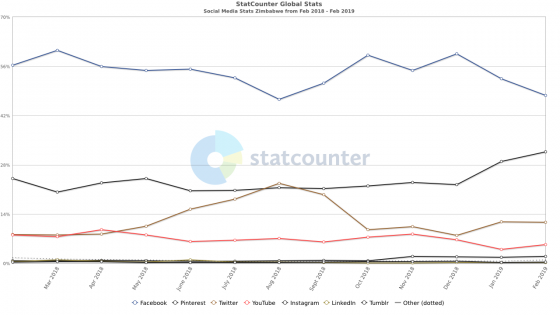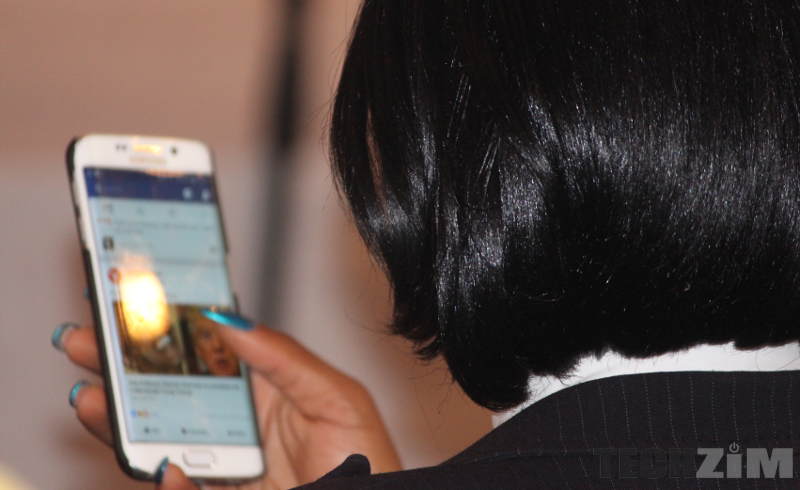Back in 2015, we came upon the discovery that Pinterest was the second most popular social network in Zimbabwe. This was quite shocking because this was shortly after Econet’s Free Twitter campaign that had made the social media platform pretty popular. Four years later Pinterest is still the second most popular social media platform in Zim according to the data on Global Stats Counter. But this time around we took a closer look at what these stats could suggest.
Here are the latest Stats on traffic received by Global Stats:

[visualizer id=”1943863″]
This is kind of surprising because if you asked me I would have assumed that Twitter along with Instagram rank above Pinterest but lo and behold the data suggests otherwise. What makes this data slightly more believable is that the trend shifted in August of 2018. Remember what happened in August? The elections and the whole post-election drama meant for a while Twitter was the place to be if you wanted updates as early as possible.
Another reason why this data could be closer to the truth than you expect is that last month we discovered that Econet was working on a new set of bundles and even though those haven’t been released up until now, there was some Pinterest action there.
Is there something bigger at play?
One of the few reasons why I still had some doubts as to the accuracy of this data is due to the fact that Pinterest has been said to be the second most popular social media site but up until now, there has been no bundle for it from any of the mobile network operators. Heck, we’ve got bundles for Instagram which seems to be one of the least popular social media sites in Zimbabwe according to the stats by Global Counter.
Though the stats suggest otherwise we also shouldn’t entirely disregard the eye test. I have never (not once) come across a Zimbo who uses Pinterest. I am also yet to see businesses make use of the tool. Now that’s not to say that my lack of knowledge should mean anything but when we couple that with the fact that many people are taken aback when you even suggest that this is the second largest social media site one can’t help but wonder, “where are these Pinterest users hiding?”
Lastly, Pinterest is an Image-heavy website and thus one would expect that it consumes data heavily. I’m therefore quite surprised that it’s not held back by the same constraints that hold Instagram back. A lot of people love IG but a common complaint we hear time and time again is that Insta runs riot on your data like a Zimbabwean incensed by fuel prices.
How do they get this data?
Anyway, all these arguments that go against the stats prompted to dig deeper and actually understand what these stats mean… I had to take a closer look at Global Stats Counter’s compilation process to better understand how they got to this conclusion.
Amongst Global Stats FAQs there are two questions I found pertinent. The first one was, How do you calculate the social media stats? Global stats explains this as follows:
We rank social media sites according to their traffic generation capabilities i.e. the amount of traffic they refer to other websites. We do NOT rank social media sites according to the amount of traffic they receive.
The second and equally important question that’s asked is, How do you calculate stats for twitter? Global stats offers the clarification below:
We rank social media sites according to their traffic generation capabilities i.e. the amount of traffic they refer to other websites.
Before 24 August 2011, Twitter referrals in StatCounter Global Stats are understated. This is because many third party twitter clients do not provide referral information. Referral stats were largely based, therefore, on referrals from twitter.com; referrals from many mobile/desktop twitter clients being unavailable.
While Twitter had been testing its automatic link shortening service for some time, the new t.co feature was rolled out on a wide scale in August 2011. You can learn more about the t.co URL shortener here and here.
The use of this automatic link shortening now allows more accurate analysis of twitter referrals. In other words, referring links which were previously unavailable due to the use of third party twitter clients can now be successfully tracked.
From 24 August, we have updated our detection and now include t.co links for twitter. In many regions this resulted in a significant jump for twitter on our Social Media stats graphs.
It should be noted that it is possible for t.co links to be copied from twitter and pasted on to a blog or other website. In such a case, a t.co referral would be included as a twitter referral within our Global Stats despite the referral having come from a different website. This scenario indicates that Twitter referrals may now be slightly overstated, however, we expect such overstatement to be small.
And therein lies the issue with Global Counter’s stats and how we initially interpreted the data four years ago. Pinterest is probably not more popular than Twitter in Zimbabwe if we are looking at users. So it’s not that the stats from our article four years ago (or this one) were inaccurate. It was simply a wrong interpretation (by us) of what the data presented meant.
So in fact, Pinterest is NOT the second most popular social media platform in Zimbabwe but it seems to generate the second largest amount of page views among social media sites. You can then see why sites such as Twitter and Instagram are not ranked as you would expect as their interfaces don’t really encourage referrals, which is especially true when it comes to Instagram which requires you have a certain threshold of followers to be able to just post a link.

One response
To better put these stats into perspective it would help to understand a little of how Pinterest works, it may be a social media site and on the surface it seems similar to Instagram but only in that they are both visual platforms.
Pinterest is more like a visual search engine that enable users to find content, bookmark and even curate it, and most most of its user are actively looking for specific content than just socialising. Most “Pins” usually have referral links to websites, which explains the large referral rate and also even when one is not actively on the Pinterest site, the images from there appear on search engine results and so without even realising/recognising it one becomes part of the Pinterest stats. This also explains why though Pinterest has a rather low subscriber base, its engagement and referral rate is surprisingly very high.